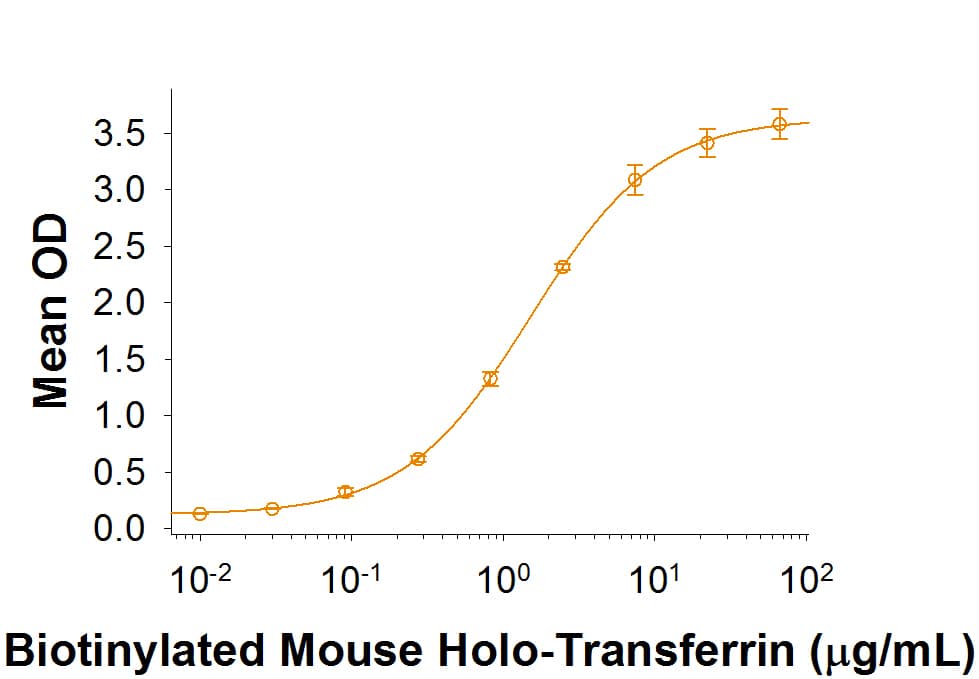Recombinant Mouse TfR (Transferrin R) Protein, CF
R&D Systems, part of Bio-Techne | Catalog # 9706-TR

Key Product Details
Source
CHO
Accession #
Structure / Form
Disulfide-linked homodimer
Conjugate
Unconjugated
Applications
Bioactivity
Product Specifications
Source
Chinese Hamster Ovary cell line, CHO-derived mouse TfR (Transferrin R) protein
Cys89-Phe763, with an N-terminal 6-His tag
Cys89-Phe763, with an N-terminal 6-His tag
Purity
>95%, by SDS-PAGE visualized with Silver Staining and quantitative densitometry by Coomassie® Blue Staining.
Endotoxin Level
<0.10 EU per 1 μg of the protein by the LAL method.
N-terminal Sequence Analysis
His
Predicted Molecular Mass
77 kDa
SDS-PAGE
75-86 kDa (major) and 133-157 kDa (minor), under reducing conditions.
Activity
Measured by its binding ability in a functional ELISA.
When Recombinant Mouse TfR (Transferrin R) (Catalog # 9706-TR) is immobilized at 5 µg/mL (100 µL/well), Biotinylated Mouse Holo-Transferrin binds with an ED50 of 20.0-160 ng/mL.
When Recombinant Mouse TfR (Transferrin R) (Catalog # 9706-TR) is immobilized at 5 µg/mL (100 µL/well), Biotinylated Mouse Holo-Transferrin binds with an ED50 of 20.0-160 ng/mL.
Scientific Data Images for Recombinant Mouse TfR (Transferrin R) Protein, CF
Recombinant Mouse TfR (Transferrin R) Protein Binding Activity
When Recombinant Mouse TfR (Catalog # 9706-TR) is coated at 5 µg/mL (100 µg/mL), Biotinylated Mouse Holo-Transferrin binds with an ED50 of 0.4-2.4 μg/mL.Formulation, Preparation and Storage
9706-TR
| Formulation | Lyophilized from a 0.2 μm filtered solution in PBS with Trehalose. |
| Reconstitution |
Reconstitute at 500 μg/mL in PBS.
|
| Shipping | The product is shipped at ambient temperature. Upon receipt, store it immediately at the temperature recommended below. |
| Stability & Storage | Use a manual defrost freezer and avoid repeated freeze-thaw cycles.
|
Background: TfR (Transferrin R)
References
- Stearne P.A. et al. (1985) J. Immunol. 134:3474.
- Daniels, T.R. et al. (2006) Clin. Immunol. 121:144.
- Skikne, B.S. (2008) Am. J. Hematol. 83:872.
- Macedo, M.F. and M. deSousa (2008) Inflamm. Allergy Drug Targets 7:41.
- Aisen, P. (2004) Int. J. Biochem. Cell Biol. 36:2137.
- Radoshitzky, S.R. et al. (2007) Nature 446:92.
Long Name
Transferrin Receptor
Alternate Names
CD71, TfR (TransferrinR), TFR1, TFRC, TRFR
Gene Symbol
TFRC
UniProt
Additional TfR (Transferrin R) Products
Product Documents for Recombinant Mouse TfR (Transferrin R) Protein, CF
Product Specific Notices for Recombinant Mouse TfR (Transferrin R) Protein, CF
For research use only
